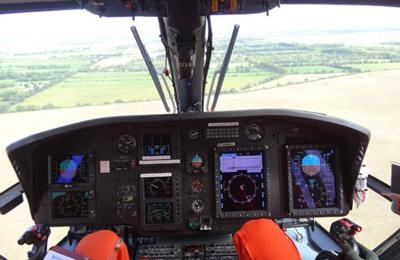Tue, Jul 16, 2013
Augmented Satellite Approaches Lead To Quieter Helicopter Landing Procedures
Eurocopter has successfully demonstrated new landing procedures relying on augmented satellite guidance that can be tailored to more completely comply with the local environmental requirements. These new landing procedures were validated with a twin-engine Eurocopter EC155 during flight tests performed as part of the company’s participation in the Green Rotorcraft Integrated Technology Demonstrator program – which is part of Europe’s Clean Sky Joint Technology Initiative.

Eurocopter’s validation flights demonstrated significant reductions in the helicopter’s perceived sound footprint - consistent with predictions. They also confirmed that such automated low-noise approaches could be tailored to local environmental requirements, thereby optimizing Eurocopter helicopter operations for even the most sensitive environments.
The flight testing involved the use of optimized noise abatement flight paths compatible with Instrument Flight Rules (IFR) operations. During the EC155’s landing approaches, vertical guidance was provided by EGNOS, the European Satellite-Based Augmentation System (SBAS), with the helicopter’s Flight Management System (FMS) coupled to the Automatic Flight Control System (AFCS). This enabled the new approach profiles to be flown accurately, minimizing the pilot workload with an automatic monitoring of speed profiles and ascent/descent rates.
“Improving the neighbor-friendly aspects of rotorcraft continues to be a priority for us, and these new tests underscore how advanced flight guidance systems can be brought together with the latest navigation technologies to reduce perceived sound,” said Yves Favennec, Vice-President of Research at Eurocopter.
The Green Rotorcraft Integrated Technology Demonstrator program that supported Eurocopter’s EC155 flight evaluations is part of the Clean Sky Joint Technology Initiative, which is Europe’s most ambitious aeronautical research program ever. Clean Sky’s goal is to develop breakthrough technologies that significantly increase environmental performance of the air transport sector, resulting in quieter and more fuel efficient aircraft and rotorcraft
Eurocopter is a founding member of the Clean Sky Joint Technology Initiative, and recently joined with its other members to propose an extension of this effort during the 2014-2024 time period.
(Image provided by Eurocopter.)
More News
He Attempted To Restart The Engine Three Times. On The Third Restart Attempt, He Noticed That Flames Were Coming Out From The Right Wing Near The Fuel Cap Analysis: The pilot repor>[...]
Make Sure You NEVER Miss A New Story From Aero-News Network Do you ever feel like you never see posts from a certain person or page on Facebook or Instagram? Here’s how you c>[...]
From 2009 (YouTube Edition): Leading Air Show Performers Give Their Best Advice for Newcomers On December 6th through December 9th, the Paris Las Vegas Hotel hosted over 1,500 air >[...]
Aero Linx: NASA ASRS ASRS captures confidential reports, analyzes the resulting aviation safety data, and disseminates vital information to the aviation community. The ASRS is an i>[...]
“For our inaugural Pylon Racing Seminar in Roswell, we were thrilled to certify 60 pilots across our six closed-course pylon race classes. Not only did this year’s PRS >[...]
 NTSB Final Report: Rutan Long-EZ
NTSB Final Report: Rutan Long-EZ ANN FAQ: Turn On Post Notifications
ANN FAQ: Turn On Post Notifications Classic Aero-TV: ICAS Perspectives - Advice for New Air Show Performers
Classic Aero-TV: ICAS Perspectives - Advice for New Air Show Performers ANN's Daily Aero-Linx (06.28.25)
ANN's Daily Aero-Linx (06.28.25) Aero-News: Quote of the Day (06.28.25)
Aero-News: Quote of the Day (06.28.25)



